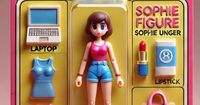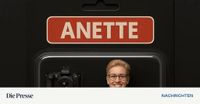In recent weeks, a new digital trend has taken social media by storm, allowing users to create personalized action figures of themselves using OpenAI's ChatGPT image generator. This phenomenon has not only captivated everyday users but also politicians and brands, making it a unique blend of creativity and technology.
Since the optimization of ChatGPT's image generator in early April 2025, users have been able to generate images with unprecedented precision, leading to a surge in creativity across platforms like Instagram, TikTok, and Facebook. Following the viral Ghibli trend, which had users generating images in the style of the renowned Japanese animation studio, individuals began exploring new avenues for self-expression through action figures.
Notable figures have joined the trend, including politicians such as Beate Meinl-Reisinger and Andreas Schieder, who have shared their own action figures online. These creations often feature humorous designs or accessories that reflect their personalities or professions. For example, Minister President Winfried Kretschmann of Baden-Württemberg was depicted with a VfB Stuttgart scarf and a book by Hannah Arendt, while Finance Minister Danyal Bayaz was illustrated with a basketball and Euro coins.
Creating an action figure is straightforward. Users simply need to open ChatGPT, select the image generator, and input a prompt. The process may involve uploading a photo for better accuracy. A sample prompt could be: "Create a high-quality 3D rendering of a cartoon-like figure, presented in a blister pack styled like a collector's toy." Users can customize their figures with specific clothing, accessories, and backgrounds, allowing for a personal touch.
The article outlines the steps for generating these action figures, emphasizing the importance of a precise prompt. Users are encouraged to upload a full-body photo for optimal results. The trend has even led to the creation of animated videos, with users utilizing platforms like kling.ai to bring their action figures to life.
However, as with any trend that involves creative expression, copyright concerns arise. Users are advised to be cautious when using images associated with well-known brands or characters. The key is to ensure that the figures created do not infringe on existing copyrights while still allowing for personal creativity.
In a humorous twist, Lena Schwelling, the state chairwoman of the Greens, created a "Green Force Edition" figure that features a baby carrier and a map of Ulm, along with the slogan, "The future is female – and carries a diaper supply in her backpack." This playful approach highlights how the trend can be used not only for personal enjoyment but also as a tool for political messaging.
Additionally, businesses have begun leveraging this trend for recruitment purposes. For instance, a pharmacy in Bad Buchau has created action figures of its pharmaceutical-commercial employees, promoting the slogan: "Forget Marvel – we create real heroes!" This innovative approach not only showcases the pharmacy's team but also engages potential recruits in a fun and memorable way.
The action figure trend serves as a testament to the intersection of technology, creativity, and social media. As users continue to experiment with ChatGPT's capabilities, the possibilities for self-expression seem endless. Whether for personal enjoyment, political satire, or marketing strategies, these AI-generated action figures have sparked a wave of creativity that resonates across various demographics.
As the trend evolves, it will be fascinating to see how users continue to push the boundaries of what is possible with AI-generated imagery. The blend of nostalgia for childhood toys and the modern capabilities of artificial intelligence has created a unique cultural moment that invites everyone to participate.
In summary, the action figure trend powered by ChatGPT is more than just a fleeting social media craze; it represents a new form of digital expression that combines creativity, humor, and personal branding. As more users dive into this phenomenon, the landscape of self-representation is likely to shift dramatically, encouraging a playful exploration of identity through the lens of technology.







